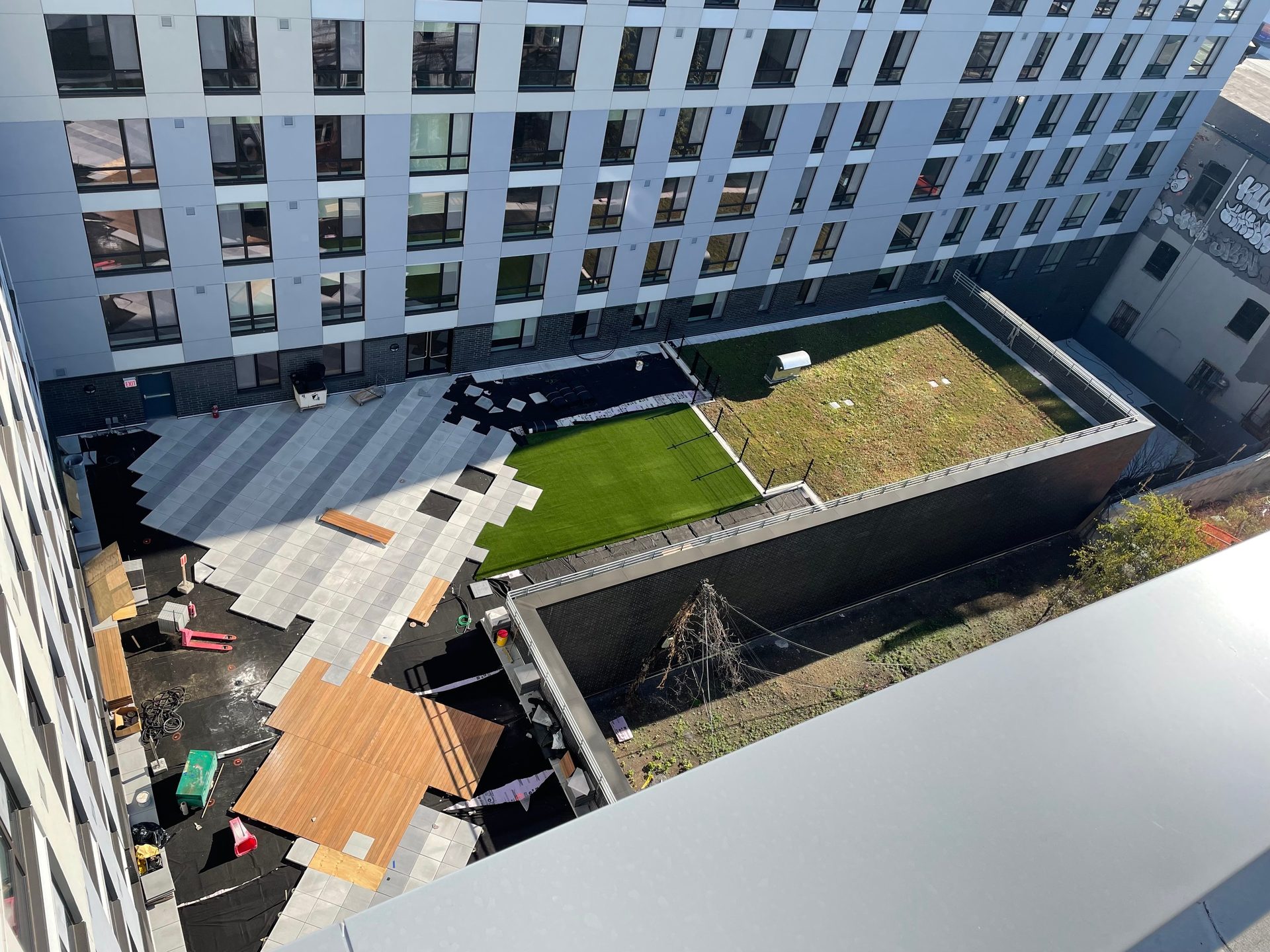Learning Objectives:
By the end of this course, the reader should be able to:
- Define sustainability.
- Evaluate operational carbon, embodied carbon, and whole life carbon footprint of buildings.
- Discuss how roofing contributes to sustainability goals.
- Integrate holistic system design approaches to roofing overburden.

Introduction
Sustainability is too often seen as an afterthought to how we design and construct buildings. However, if we shift our thinking to a more holistic approach to not only the building itself but how it interacts with its surrounding environment and community, and use collaborative design from the start of the design process, the carbon footprint can be minimized, and limiting global Greenhouse Gas (GHG) emissions to 1.5 degrees Celsius can be achieved.1
Commercial roofs can be “benefit multipliers” by integrating renewable energy, rainwater management strategies, and rooftop agriculture to address our changing environment and more severe storms.
The intent of this course is to discuss the interconnectedness and interrelations of roof strategies that can help minimize whole building carbon emissions while, at the same time, improve long-term performance, durability, and resiliency by using overburden strategies to alleviate the community burden of climate change.
Let’s Start with a Definition
In 1987, the United Nations Brundtland Commission defined sustainability as “meeting the needs of the present without compromising the ability of future generations to meet their own needs.”2 While this definition can be interpreted as overly simplistic and too broad, it highlights the key ingredient of sustainable development: time. It is specifically the temporal component that we as humans seem to struggle with. We tend to create a false dichotomy between short-term gains and long-term impacts. However, sustainability is not asking us to sacrifice our needs today, quite the opposite. It is explicitly telling us that we should meet our needs today; however, we must not get bogged down in short-term thinking and keep an eye on the future to ensure future generations are not jeopardized by the decisions we make now.
The Earth is Warming: IPCC Report
The climate data in the most recent International Panel on Climate Change (IPCC) report makes it evident that the Earth is warming and the effects of climate change are already being felt. The IPCC 2021 report states, “It is unequivocal that human influence has warmed the atmosphere, ocean and land. Widespread and rapid changes in the atmosphere, ocean, cryosphere and biosphere have occurred.”3
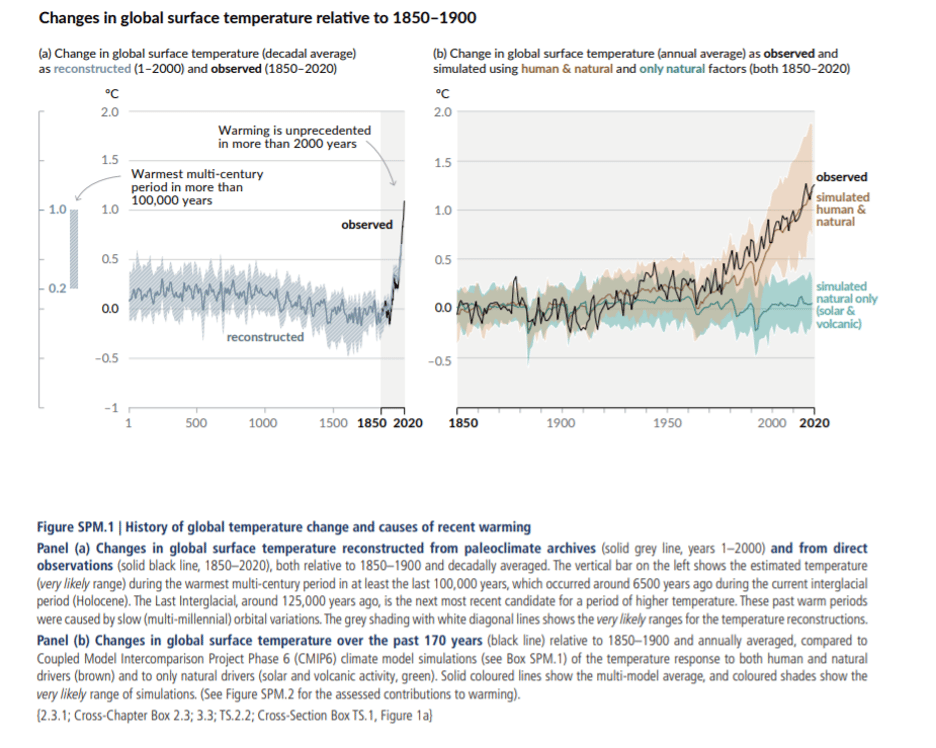
Figure 1
U.S. 2021 Billion-Dollar Weather and Climate Disasters. Image courtesy of NOAA.
Figure 2
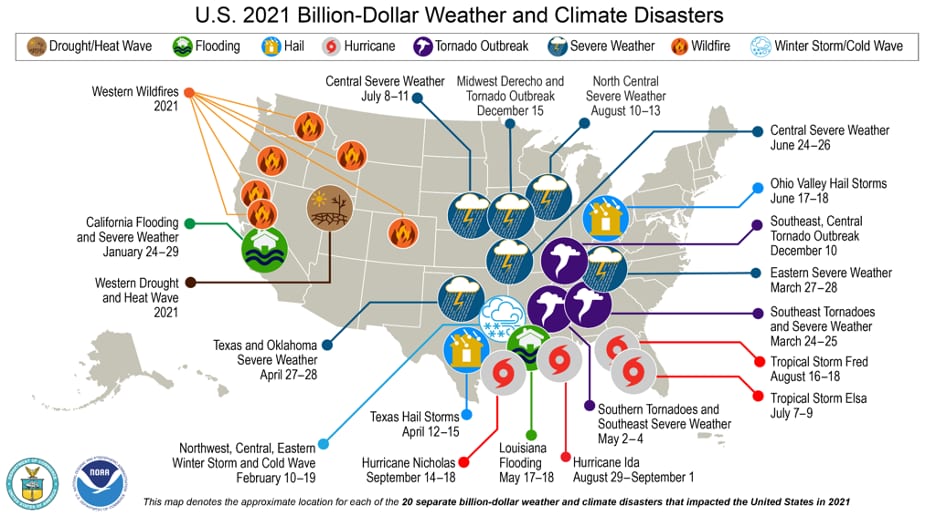
Cost of Disaster Events. Image courtesy of NOAA.
Figure 3

Frequency of Disaster Events. Image courtesy of NOAA.
Figure 4

It’s Not Too Late—Architecture 2030
At the 2021 United Nations Climate Change Conference, more commonly known as COP26, Ed Mazria from Architecture 2030 delivered a road map on how the built environment can reach zero emissions by 2040. If CO2 emissions are reduced 65 percent by 2030, there is a better than 67 percent probability that zero emissions can be met by 2040.7 As Mark C. Pederson noted in 2020, “The news about real action on climate change tends to track toward the gloomy. It is easy to despair, given the severity of the problem and the time left to properly address it. But there is progress being made in the built environment—just not nearly fast enough to offset emissions elsewhere. In recent years the sector has added billions of square feet of new buildings, but seen energy consumption for the entire sector actually decline.”8
In other words, building energy efficiency measures are working and we have already decoupled emissions from building energy use. This is a cause for optimism, as this has been accomplished even as the population continues to grow. One of the main contributors to efficiency improvements over the last decade has been building enclosure upgrades that use more robust continuous insulation, air tightness measures, and—the opposite side of the same coin—more efficient mechanical systems for ventilation, heating and cooling. While it’s tempting to give all the credit to the natural gas transition and renewable energy installations, the impact of high efficiency building enclosures cannot be underestimated. On the other hand, we need to do better and we can do better. By going beyond code minimums and using holistic energy efficiency design strategies for all new construction, net-zero operational emissions can easily and cost effectively be met today. However, the main obstacle to accomplish this at scale is not a technological issue, it’s a labor issue. In order to reduce the building sector’s emissions to meet Architecture 2030’s goals, it must be done rapidly and at scale. The construction industry requires a massive workforce development and training program on how to build and retrofit existing buildings using energy efficiency design principles. This workforce development applies not only to younger generations, but also to older workers who need new skills where their industries have become obsolete. An added benefit to scaling workforce development for energy efficient construction is that construction jobs tend to be localized which keeps money in the local community, creates other local businesses to support the construction sector, and provides a more resilient local economy that is buffered from global market fluctuations in an increasingly volatile stock market.
There’s a 67 percent probability of meeting the 1.5 degree C target if CO2 is reduced 65 percent by 2030. Image courtesy of Architecture 2030.
Figure 5
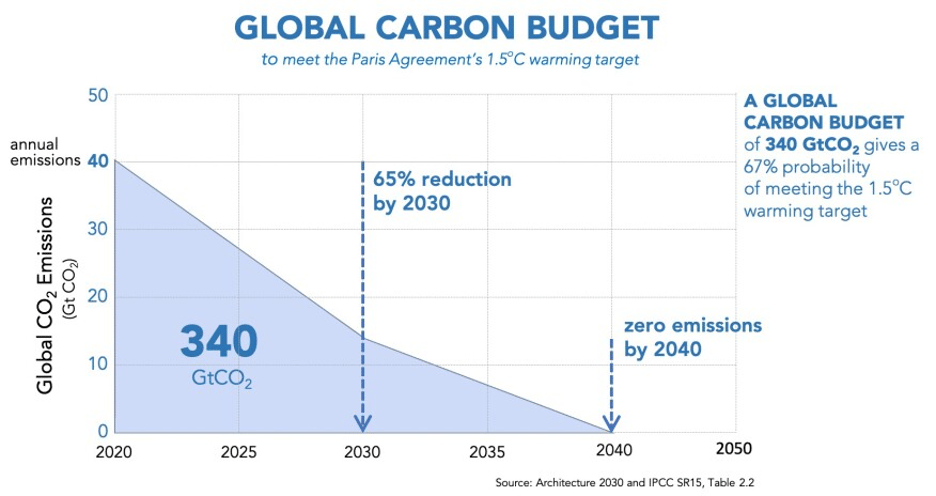
It is commonly thought that buildings account for approximately 30-40 percent of GHG emissions. However, as the chart below shows, when we factor in the embodied carbon, or “... the greenhouse gas emissions arising from the manufacturing, transportation, installation, maintenance, and disposal of building materials of building materials and construction,” buildings account for nearly half of global emissions.9 If we look at urban centers like New York City, over 70 percent of emissions come from building operations, (i.e, heating, cooling, and plug loads).10In addition, approximately 83 percent of the U.S. population lives in cities.11 So, it follows that fixing the urban built environment can have the greatest impact to realize climate action goals and preserve the welfare of the most people. As noted earlier, this is no small task and requires a collaborative holistic approach as well as workforce training and mobilization at a scale not seen since World War II.
The building sectors contribution to CO2 emissions. Image courtesy of Architecture 2030.
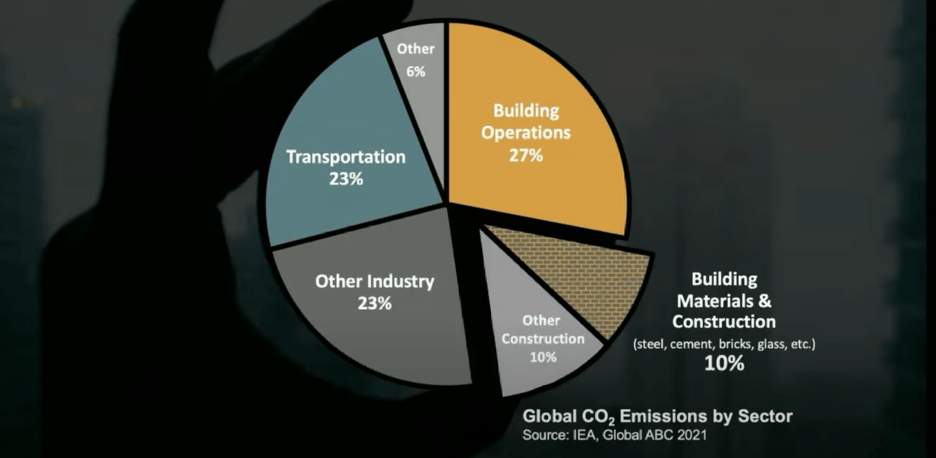
Figure 6
While there is a role for government in incentivizing a rapidly scaling market transformation, the private sector is the main driver in affecting this change. In fact, some manufacturers already have trade training programs to educate the unemployed, the underemployed, military veterans, and the formerly incarcerated at a scale to meet the labor shortages that already exist in the construction industry.12 It is not a huge leap to incorporate energy efficiency principles into these types of training programs.
With many U.S. states and car manufacturers setting goals for 100 percent electrification by 2035, transforming the built environment has the unique capability to significantly reduce or eliminate emissions from the transportation sector. This, however, requires a shift from the traditional way of thinking about buildings as static, standalone units to a dynamic part of a larger interconnected community infrastructure ecosystem. Every building has the potential to generate more energy than it uses. By integrating rooftop solar, electric vehicle charging infrastructure, and battery storage into energy efficient building designs, a large part or all of the transportation sector emissions can potentially be eliminated. This not only helps reduce emissions but also reduces transmission losses from delivering electricity over long distances and creates a more resilient localized energy grid to minimize power outages from the aging large scale electric infrastructure.
So What Does This Have to Do with Roofing?
The primary purpose of roofs is to provide shelter from the elements. However, roofs are the often unseen work horses of our buildings. Roofs already do a lot of heavy lifting, both literally and figuratively. Whether it’s providing protection against wind, rain, snow and hail, or reflecting solar rays, supporting rooftop mechanicals, minimizing fire risk, providing daylighting, and insulating—roofs humbly endure for decades.
This “out of sight and out of mind” perception of roofs is changing rapidly as the population grows and becomes increasingly urbanized in a warming world. In New York City, Local Laws 92 & 94 have already been enacted and require that, “The sustainable roof must include a solar photovoltaic system generating at least 4kW, a green roof system, or a combination of the two. Vertical or horizontal enlargements must also comply with these requirements.”13 In addition to the solar and vegetated roof mandate in NYC, “Local Law 94 increases the SRI (solar reflectance index) of cool roofs to keep up with LEED v4. The law also adds new reflectance requirements for sloped roofs. Coatings are readily available, inexpensive and easy to apply.”14
Similar laws and ordinances exist in various cities across the U.S. For example, Seattle has the Seattle Green Factor, a landscaping requirement that green roofs can help meet.15 In addition, Seattle is also requiring roofs to be solar energy ready.16 Washington, D.C. has rebates for vegetated roofs to help manage rainwater, and initiatives for rooftop solar.17,18
Roofs now may need to incorporate vegetation, rainwater capture, rainwater retention/detention, and solar arrays. In addition, roofs are now being used for urban agricultural purposes, biodiversity restoration, and much needed outdoor greenspace in cities with high population densities. Roofs are a climate benefit multiplier that sustainability professionals and the AEC community alike should be collaborating on to develop strategies and solutions for.
End Notes
1Architecture 2030. “Accelerating to Zero by 2040!” Oct. 2019. Web. 22 Feb. 2022. <https://architecture2030.org/accelerating-to-zero-by-2040/ >
2https://www.un.org/en/academic-impact/sustainability Accessed 2/4/2022 at 9:33am.
3Intergovernmental Panel on Climate Change. “Climate Change 2021: The Physical Science Basis Working Group I: Contribution to the Sixth Assessment Report of the Intergovernmental Panel on Climate Change.” Oct. 2021. Web. 4 Feb. 2022. <https://www.ipcc.ch/report/ar6/wg1/downloads/report/IPCC_AR6_WGI_SPM_final.pdf>
4National Oceanic and Atmospheric Administration (NOAA). “2021 U.S. billion-dollar weather and climate disasters in historical context.” 24 Jan. 2022. Web. 6 Feb 2022.
5Intergovernmental Panel on Climate Change. “Climate Change 2021: The Physical Science Basis Working Group I: Contribution to the Sixth Assessment Report of the Intergovernmental Panel on Climate Change.” Oct. 2021. Web. 4 Feb. 2022. <https://www.ipcc.ch/report/ar6/wg1/downloads/report/IPCC_AR6_WGI_SPM_final.pdf>
6Headline Statements. Intergovernmental Panel on Climate Change. Web. 8 Feb. 2022. <https://www.ipcc.ch/sr15/resources/headline-statements/>
7Architect Magazine Staff and Mazria, Edward. “Architecture 2030's Open Letter to the UN Framework Convention on Climate Change Calls for Revised Carbon Emission Reduction Targets.” Architect Magazine, 6 Nov. 2020. Web. 18 Feb. 2022. <https://www.architectmagazine.com/technology/architecture-2030s-open-letter-to-the-un-framework-convention-on-climate-change-calls-for-revised-carbon-emission-reduction-targets_o>
8Pedersen, Martin C. “Edward Mazria With Some Good News About Combating Climate Change.” “Common Edge,” 27 July 2020. Web. 9 Feb. 2022. <https://commonedge.org/edward-mazria-with-some-good-news-about-combating-climate-change/>
9Carbon Leadership Forum. “Embodied Carbon 101.” 17 Dec. 2020. Web. 8 Feb. 2022. <https://carbonleadershipforum.org/embodied-carbon-101>
10NYC Mayor’s Office of Climate & Environmental Justice. “Energy Benchmarking:
Energy map.” New York City Energy & Water Performance Map.” Web. 8 Feb. 2022. <https://www1.nyc.gov/site/sustainability/codes/energy-benchmarking.page#:~:text=Over 70 percent of New,on energy and water management>
11Center for Sustainable Systems, University of Michigan. 2021. "U.S. Cities Factsheet." Pub. No. CSS09-06. Web. 8 Feb 2022. <https://css.umich.edu/factsheets/us-cities-factsheet#:~:text=It is estimated that 83,to live in urban areas>
12Saulsbery, Gabrielle. “Peak Demand: Parsippany-based GAF addresses a serious labor shortage by training new roofers.” NJBiz. 17 May 2021. Web. 17 Feb. 2022. <https://njbiz.com/peak-demand-gaf-roofer-training/>
13La Rocca, Melanie E. “Service Notice: Local Law 92 of 2019 and Local Law 94 of 2019: Green and Solar Roof Requirements for New Buildings and Complete Roof Replacements.” NYC.gov. Oct. 2019. Web. Feb 9 2022. <https://www1.nyc.gov/assets/buildings/pdf/green_roof_solar_ll92-n-94of2019_sn.pdf>
14Urban Green Council and The Nature Conservancy. “NYC’S SUSTAINABLE
ROOF LAWS.” Urban Green Council. Dec. 2019. Web. 10 Feb. 2022. <https://www.urbangreencouncil.org/sites/default/files/sustainable_roof_laws_brief_final_12.11.19.pdf>
15Torgelson, Nathan. “Seattle Green Factor.” Seattle.gov. Web. 18 Feb. 2022. <https://www.seattle.gov/sdci/codes/codes-we-enforce-(a-z)/seattle-green-factor#:~:text=You can choose from a,or create a food garden>
16Seattle Department of Construction & Inspections. “Renewable Energy and Solar-Ready Roofs for Commercial Buildings.” Seattle.gov. 18 Oct 2021. Web. 14 Feb 2022. <http://www.seattle.gov/DPD/Publications/CAM/Tip422.pdf>
17Washington, D.C. Department of Energy & Environment. “Green Roofs in the District of Columbia.” Web. 22 Feb. 2022. <https://doee.dc.gov/greenroofs>
18Washington, D.C. Department of Energy & Environment. “Solar Initiatives.” Web. 22 Feb. 2022.
19World Green Building Council. “Whole Life Carbon Vision.” WorldGBC.org. Web. 4 Feb. 2022. <https://www.worldgbc.org/advancing-net-zero/whole-life-carbon-vision>
20Tobias, Michael. “Green Building Trends: Pros & Cons of Passive House Construction.” NewYork Engineers. 12 October 2021. Web. 17 Feb. 2022. <https://www.ny-engineers.com/blog/green-building-trends-pros-cons-of-passive-house-construction>
21Taylor, T.J. “Eliminating Fastener Thermal Bridging in Low Slope Roofs: Energy Efficiency Savings versus Installation Costs.” Open Journal of Energy Efficiency. 9, 94-110. June 2022. Web. 20 Feb. 2022. < https://doi.org/10.4236/ojee.2020.92007>
22Ibid.
23World Green Building Council. “Whole Life Carbon Vision.” WorldGBC.org. Web. 4 Feb. 2022. <https://www.worldgbc.org/advancing-net-zero/whole-life-carbon-vision>
24Ellen MacArthur Foundation. “What is a circular economy?” Web. 17 Feb 2022. <https://ellenmacarthurfoundation.org/topics/circular-economy-introduction/overview>
25Reuters. “U.S. corn-based ethanol worse for the climate than gasoline, study finds.” Autoblog. 21 Feb. 2022. Web. 2 Feb 2022.
26GAF Roof Views. “Welcome to the Future of Asphalt Recycling.” GAF.com. 21 April 2021. Web. 17 Feb 2022. <https://www.gaf.com/en-us/blog/welcome-to-the-future-of-asphalt-recycling-281474980090173>
27MYCOCYCLE. Web. 22 Feb 2022. <https://mycocycle.com/>
28Acaroglu, Leyla. “The Trap of Wishcycling.” Disruptive Design. 8 Sep. 2021. Web. 22 Feb. 2022. <https://medium.com/disruptive-design/the-trap-of-wishcycling-6ea083646876>
29Siegel, Henry and Strain, Larry. “Embodied Carbon: What you Can Do Right Now.” AIA California. 5 March 2020. Web. 8 Feb. 2022. <https://aiacalifornia.org/embodied-carbon-definitions-and-facts/>
30Nadeeshani, Malka et al. “Carbon Footprint of Green Roofing: A Case Study from Sri Lankan Construction Industry.” Sustainability 2021, 13, 6745. 15 June 2021.
31Clancy, Heather. “Carbon-sucking concrete is capturing attention and funding.” GreenBiz. 6 May 2021. Web. 17 Feb. 2022. <https://www.greenbiz.com/article/carbon-sucking-concrete-capturing-attention-and-funding>
32PLC-Portland Limestone Cement. “Portland-Limestone Cement U.S. Fact Sheet.” Greener Cement. Web. 17 Feb. 2022. <https://www.greenercement.com/_files/ugd/f3d485_bf593dd744f049d98cbd293109fc42ce.pdf>
33Tosti, Lorenzo et al. “Technical and environmental performance of lower carbon footprint cement mortars containing biomass fly ash as a secondary cementitious material.” Resources, Conservation and Recycling. Volume 134. July 2018.<https://doi.org/10.1016/j.resconrec.2018.03.004>
34.Overbey, Daniel. “Defining a Whole-Building Embodied Carbon Workflow.” Building Enclosure. 30 June 2021. Web. 9 Feb. 2022. <https://www.buildingenclosureonline.com/blogs/14-the-be-blog/post/89961-defining-a-whole-building-embodied-carbon-workflow>
35Alter, Lloyd. “New Tool Calculates Full Life Cycle Carbon Emissions for Passive House.” Treehugger. 25 Jan 2022. Web. 9 Feb 2022. <https://www.treehugger.com/tool-lifecycle-carbon-emissions-passive-house-5216866>
36International Living Future Institute and Passive House Institute. “Zero Energy &
Passive House Certifications.” 2019. Web 22 Feb. 2022. <https://living-future.org/wp-content/uploads/2019/07/Zero_Energy_PassiveHouse_Crosswalk-1.pdf>
37Ibid.
38Resilient Design Institute. “What is Resilience?” Resilient Design. Web. 4 Feb. 2022. <https://www.resilientdesign.org/defining-resilient-design/>
39Roofing Contractors Association of British Columbia. “Template: ROOFTOP EQUIPMENT & WALKWAYS (BUR).” Web. 4 Feb. 2022. <https://rpm.rcabc.org/index.php/Template:ROOFTOP_EQUIPMENT_&_WALKWAYS_(BUR>
40Green Roofs for Healthy Cities. “About Green Roofs.” Greenroofs.org. Web 10 Feb. 2022. <https://greenroofs.org/about-green-roofs>
41Simon, Matt. “Your Rooftop Garden Could Be a Solar-Powered Working Farm.” “Wired,” 3 Dec. 2021. Web. 17 Feb. 2022. <https://www.wired.com/story/your-rooftop-garden-could-be-a-solar-powered-working-farm/>
42Urban Green Council and The Nature Conservancy. “NYC’S SUSTAINABLE
ROOF LAWS.” Urban Green Council. Dec. 2019. Web. 10 Feb. 2022. <https://www.urbangreencouncil.org/sites/default/files/sustainable_roof_laws_brief_final_12.11.19.pdf>
43Ibid.
44Javits Center. “Green Roof Tours.” Javits Center. Web 7 Feb. 2022. <https://javitscenter.com/sustainability/green-roof-tours/>
45Sokol, David. “Rooftop Farm Soars Above the City.” Architectural Record. 15 Dec. 2021. Web. 7 Feb. 2022. <https://www.architecturalrecord.com/articles/15429-rooftop-farm-soars-above-the-city>
46Designing Buildings. “Blue Roof.” 15 Dec. 2021. Web. 22 Feb. 2022. <https://www.designingbuildings.co.uk/wiki/Blue_roof>
47Livingroofs.org. “The blue green roof—helping cities cope with stormwater.” Web. 22 Feb. 2022. <https://livingroofs.org/introduction-types-green-roof/blue-green-roof-cities-stormwater/>
48SemperGreen USA. “Purple-Roof Case Study.” 12 Oct. 2021. Web. 22 Feb. 2022. <https://www.sempergreen.com/en/sempergreen-academy/webinar-innovation-for-future-proof-cities>
Shawn Torbert, M.S., CPHC/D, LEED AP is the Commercial Design Sustainability Manager at GAF and Siplast. He studied molecular biology, philosophy, and writing at Lehigh University and holds a Master of Science degree in Sustainability Management from Columbia University in the City of New York. Shawn is a LEED AP, a Passive House Institute Certified Passive House Consultant/Designer and volunteers as a Passive House Trainer for the Passive House Network.
Quiz
1. Sustainability is:
- A marketing strategy used by businesses to increase profits.
- A holistic strategy to meet the needs of the present without compromising the ability of future generations to meet their own needs.
- A political wedge used by politicians to get re-elected.
- A financial strategy to de-risk investments.
2. What does the International Panel on Climate Change conclude about climate change?
- Local weather is the same thing as global climate systems.
- The global warming data can be explained by an array of variables including technological advancements in modeling and monitoring, population growth, and natural phenomenon such as solar storms and volcanoes.
- There is plenty of time to debate whether climate change is happening or not.
- It is unequivocal that human influence has warmed the atmosphere, ocean and land. Widespread and rapid changes in the atmosphere, ocean, cryosphere and biosphere have occurred.
3. In U.S. cities, approximately what percentage of emissions come from buildings?
- 20 percent
- 50 percent
- 70 percent
- 100 percent
4. Net-zero operational carbon is:
- A highly energy-efficient building with all remaining energy from onsite and/or offsite renewable sources.
- A code-built building whose owner has purchased enough carbon offsets through tree plantings to claim net-zero energy status.
- A unicorn. There’s no such thing as net-zero energy buildings.
- A building that is highly efficient with upfront carbon minimized to the greatest extent possible and all remaining embodied carbon is reduced or, as a last resort, offset.
5. Net-zero embodied carbon is:
- A highly energy-efficient building with all remaining energy from onsite and/or offsite renewable sources.
- A building that is highly efficient with upfront carbon minimized to the greatest extent possible and all remaining embodied carbon is reduced or, as a last resort, offset.
- A unicorn. There’s no such thing as net-zero embodied carbon buildings.
- A building that is built only from natural materials that have been sourced locally using only manual labor or beasts of burden for transportation and construction.
6. Whole life carbon is:
- The total amount of carbon emissions released by disposing of a roof in a landfill.
- The total amount of carbon captured by planting trees to offset building material embodied carbon.
- An ancient industrial process that uses highly pressurized gases inside solidified carbonite to preserve biological organisms for intergalactic travel.
- The sum of operational carbon and embodied carbon.
7. Overburden is:
- Any manner of additional load on a roof from snow, severe hail, or wind.
- Any manner of material, equipment or installation that is situated on top of, and covering all or a portion of, a roof or waterproofing membrane assembly.
- Any manner of severe storm or “bomb cyclone” that floods sewer systems and impervious surfaces with rainwater.
- None of the above.
8. Roofs can significantly reduce the operational carbon of buildings by including:
- A thermal-bridge free roof assembly with the roof assembly seamlessly integrated into the vertical wall air barrier.
- Robust climate-specific levels of continuous insulation.
- Rooftop solar.
- All of the above
9. A purple roof refers to:
- The color of the roof membrane.
- The color of the cover board used on flat/low-slope roof.
- A roof that incorporates rainwater retention and detention with a sponge-like layer made of hydrophilic mineral wool to increase the volume of rainwater that can be retained or detained and reduces peak outflow by up to 95 percent.
- All of the above
10. In tropical climates, the lifecycle carbon emissions of a concrete roof can be reduced nearly 85 percent by:
- Adding fly ash to the concrete mix.
- Recycling the concrete at the end of its useful life.
- It can’t be done. Concrete and steel have too much embodied energy from their heavy manufacturing processes.
- A vegetated roof.
